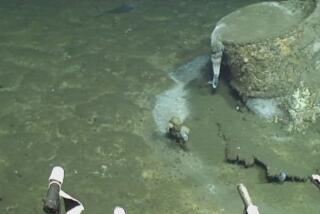Regulators badly underestimated the devastation of a possible oil spill off the O.C. coast

- Share via
Regulators scrutinizing plans for an oil pipeline off the Orange County coast in the 1970s examined the potential damage in the event of a ship anchor strike but downplayed the risks, concluding that a resulting spill would be minor, according to documents reviewed by The Times.
Regulators predicted in 1978 that a leak would result in a spill of only 50 barrels of oil, records show. That’s less than a tenth of the minimum amount of oil that leaked in waters off the Orange County coast this month in an accident investigators believe was caused when a cargo ship waiting to enter the port dropped its anchor and hit the pipeline.
Experts in oil pipeline construction now say the regulators badly underestimated the potential disaster from an anchor strike and missed an opportunity that might have prompted additional safeguards and prevented the major oil spill that fouled a long stretch of Orange County beaches.
“Their presentations were fatally flawed…. In no scenario could you come up with 50 barrels,” said Richard Kuprewicz, the president of Accufacts Inc., who specializes in gas and liquid pipeline investigations. “If there was more frank discussion of what could possibly occur it probably would have initiated discussions on what actions to take, because the risks were severely understated.”
Officials investigating the spill say an anchor probably snagged the pipeline at a point shortly after it starts its run on top of the seabed, weakening its structure and eventually causing a gash that spilled at least 588 barrels of oil. Investigators are homing in on ships that anchored in the area in January, when high winds could have caused a ship to drift and its anchor to drag across the line.
A Times review of federal data shows that anchor strikes have caused pipeline ruptures that resulted in hazardous liquids spills only 17 times since 1986, but they sometimes caused devastating damage.
Some city dwellers who’ve moved to the high desert over the last year and a half looking for more space and clean air also found unexpected drawbacks.
A spill off the Texas coast in 1988 was more than 26 times the size of this month’s in California waters. Three years ago, a barge moving through the waters between the upper and lower peninsulas of Michigan accidentally dropped its anchor and dragged the 12,000-pound device along the lake bed, severing two of the six underwater cables that supply power to Michigan’s Upper Peninsula and damaging a third, spilling about 800 gallons of dielectric mineral oil, the National Transportation Safety Board found in a 2019 report. Officials estimated that the cost to repair the cables alone was $100 million. The anchor also struck and dented, but didn’t rupture, the controversial Line 5 pipeline, which carries oil from western to eastern Canada underneath the Great Lakes.
Though anchor strikes are rare, severe weather is associated with their occurrence. Most offshore oil drilling infrastructure is designed to withstand so-called 100-year storms, giant rainfall events estimated to have a 1% chance of occurring at that location each year. But some climate experts warn that those predictions may not account for climate change, which is bringing more intense weather more often.
Hurricanes in particular have wreaked havoc on underwater infrastructure, stirring up winds forceful enough to blow even large container ships off course, break the moorings of offshore platforms and leave both dragging heavy anchors across the seafloor.
Off the Southern California coast, government regulators signed off decades ago on a plan to bury a section of the pipeline, which runs more than 15 miles between a processing platform called Elly and the shore. The buried section would run from the shore to the Long Beach breakwater. From there, the rest of the line lies on top of the seabed.
Initially, the buried part of the line was to be 4 feet under the seabed. But after concerns expressed by the U.S. Coast Guard that the depth might not be enough to prevent damage caused by maritime activities, company officials agreed to bury the line at least 10 feet below the seafloor.
The analysis — included in an environmental impact report prepared in 1978 by the U.S. Geological Survey, the State Lands Commission and the Port of Long Beach — acknowledged that there was still a chance of an anchor strike along the unburied part of the line, which runs nearly 11 miles along the ocean floor.
But it downplayed the potential spill.
“There remains the possibility that the pipeline could be ruptured or pierced by an accident, such as an emergency or accidental anchoring,” the report said. “The amount of oil spilled from the pipeline in the event of such an accident, because of the nature of the oil and the pipeline configuration, would probably be small.”
Part of the analysis relied on an overly rosy prediction that a pipeline leak detection system would work effectively enough to prevent larger spills, experts said.
Robert Bea, a UC Berkeley professor emeritus of engineering and project management and systems, said that the 50-barrel spill estimate was “sketchy superficial” and that there didn’t appear to be data to support such a scenario.
“It sounds like what I call guesstimating,” said Bea, who helped design the oil processing platform Elly.
Now, investigators have the task of trying to identify when the anchor strike occurred and which ship was involved. In some prior rupture cases, anchor strikes were strongly suspected but investigators were unable to confirm the cause.
One February morning in 1988, employees with Amoco Pipeline Co. in Texas City, Texas, noticed that the amount of oil flowing to an onshore terminal was less than the amount pumped out from the ocean.
At first, they thought the shortage was a measuring error. A helicopter dispatched to investigate confirmed the terrible scenario: an oil slick on the surface of the water 15 to 20 miles long and up to 3 miles wide. More than 15,500 barrels of oil spilled into the Gulf of Mexico, according to the records.
Divers inspecting the pipeline found it mangled and deformed. More than 100 feet of the pipeline was lifted up to eight feet above the seafloor. Portions of its concrete exterior were missing. Along with a horizontal crack in the pipe wall, divers observed “markings on it that indicated external physical contact with a foreign object,” according to a federal report of the incident.
Based on the observations, officials determined that the “pipeline damage was probably caused by an anchor snagging the pipeline,” records show.
But the finding was never conclusive, federal officials say, and because the spill occurred more than 30 miles from the coast, it drew scant attention. The operator of the pipeline believed it to be “unpredictable and unavoidable,” the records show.
In 1997, another pipeline running between two offshore oil rigs ruptured, spilling up to 15 barrels of oil off the Louisiana coast. The cause was believed to be a ship’s anchor but never confirmed, the records show.
In other incidents, the culprits were clear almost immediately.
In 2006, a pipeline 30 miles offshore from Galveston, Texas, was “severed in two” when a tanker’s crew didn’t notice the ship was drifting and dragging its anchor, eventually slicing the pipeline and spilling about 870 barrels of oil into the ocean, records show.
Federal investigators determined that the crew didn’t respond to an alarm indicating the ship was drifting and failed to notice the pipeline on a navigational chart, according to the records.
The shipmaster quickly realized what had happened and that the vessel had crossed over the pipeline, the records indicate. Members of the crew were given an alcohol test to see whether intoxication was the cause of their negligence. They tested negative, the records said.
In 2018, a catastrophic anchor strike of a pipeline in Indonesian waters killed five fishermen when the oil on the surface caught fire. For Indonesian officials, the party responsible was obvious when they determined there was only one ship in the area at the time of the spill.
Prosecutors charged the captain of the coal carrier that struck the pipeline with violating environmental protection laws. He was convicted and sentenced to 10 years in prison.
More to Read
Sign up for Essential California
The most important California stories and recommendations in your inbox every morning.
You may occasionally receive promotional content from the Los Angeles Times.














